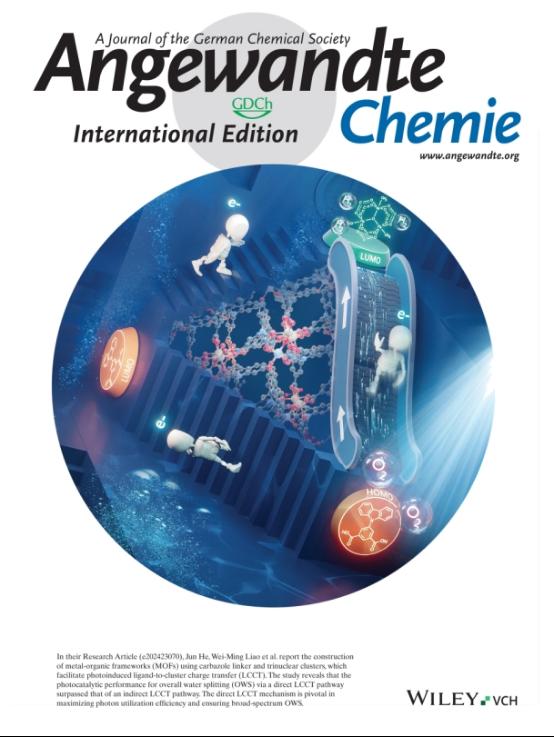Professor He Jun's team from our university achieves breakthrough progress in the field of photocatalytic overall water splitting
Author: Source: Release Date: March 25, 2025 Browses: 576 times
Professor He Jun's team from our university's Light Industry and Chemical Engineering College published the latest research results in the international top journal "Angewandte Chemie International Edition" (impact factor 16.1, a top journal in CAS Zone 1), innovatively proposing an integrated photocatalyst design strategy, successfully achieving the efficient visible light photocatalytic overall water splitting, a "holy grail"-style chemical reaction. This breakthrough work was selected as the cover paper for the issue, highlighting the innovative value and international influence of the research.

Inspired by plant photosynthesis, Professor He Jun's team focused on the key link in artificial photosynthetic systems—photocatalytic overall water splitting. This process decomposes water into hydrogen (H₂) and oxygen (O₂), providing raw materials for the subsequent reduction of carbon dioxide (CO₂) to produce high-value chemicals. The research expands the spectral response range of photocatalysts, elevating solar conversion efficiency to new heights, opening new paths for clean energy conversion.
Targeting the technical bottlenecks of traditional metal-organic framework (MOF) materials, such as narrow light absorption range (mainly limited to the ultraviolet region), and the need to add photosensitizers, sacrificial agents, or cocatalysts, the research team for the first time constructed an integrated new MOF material that combines photosensitive, catalytic, and charge transport functions. This material can achieve visible light-driven overall water splitting without adding any photosensitizers, sacrificial agents, or cocatalysts, with the hydrogen production rate improved by more than 5 times compared to existing systems.
Traditional MOF materials mostly achieve photogenerated charge separation and transfer through the indirect ligand-to-cluster charge transfer (LCCT) process, with light absorption mainly in the ultraviolet region and generally low charge separation efficiency. This work, guided by theoretical calculations, breaks through the limitations of the traditional two-step ligand-cluster charge transfer mechanism by precisely designing the energy level matching of photosensitive ligands and metal-oxo clusters at the molecular level, successfully achieving direct LCCT transitions from the ligand's highest occupied molecular orbital (HOMO) to the metal cluster's lowest unoccupied molecular orbital (LUMO), shifting light absorption to the visible region. Time-resolved spectroscopy and density functional theory calculations confirm that this direct charge transfer mechanism significantly improves the separation efficiency of photogenerated carriers.
This research not only reveals the core role of the direct LCCT mechanism in photocatalysis but also proposes a design strategy for new MOF materials. By precisely regulating the electronic structure matching between ligands and metal clusters, it provides theoretical basis and technical solutions for developing a new generation of photocatalysts with broad spectral response and high stability, which has important scientific significance for advancing the practical process of artificial photosynthetic systems.
The corresponding authors of the paper are Associate Professor Liao Weiming and Professor He Jun from the Light Industry and Chemical Engineering College, with the first author being PhD student Lin Qiaochun from the 2023 class. Guangdong University of Technology and Rongjiang Laboratory are the joint completing units of the paper.
Paper link:https://doi.org/10.1002/anie.202423070
 current position:
Home
>
News & Notices
>
News
>
Content
current position:
Home
>
News & Notices
>
News
>
Content